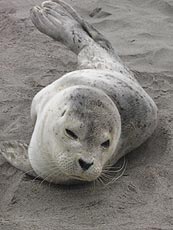 |
Video: The Weird Side of Spring on the Oregon Coast
Published 05/16/2010
 |
| Velella velella, or Purple sails are another odd delight in spring. |
(Oregon Coast) – So it's spring on these beaches - an area that’s already somewhat untamed and unpredictable, although with its decidedly commercialized moments. While you’re probably thinking spring break is the big attraction, and then there’s nothing else but rain this time of year, you couldn’t be more wrong. The truth is the place is a lot more unruly and fascinating in this season than you’d imagine, and way more diverse.
In fact, in spring, the coast can get downright weird.
Some on the coast refer to it as the “secret season” – as there is so much more going on than people realize. Yet few tourists hit the beaches during this time, other than spring break.
To begin with, there’s less people, so you’ve got the beaches to yourself. And then lodging prices are still incredibly low in most hotels or motels, creating a double whammy of enticement.
 |
| Near Oceanside: spring weather is a mix of sun, puffy clouds and incoming rain squalls. |
In April and even in March, you get an interesting mix of weather which alternates like crazy between stormy conditions and sunny skies, often within a half hour of each other.
The video here illustrates this with a sequence taken only 24 hours apart. The first day was sunny and rather warm, in the lower 60’s. The second day turned rather chilly, and even downright surreal with a briskly moving fog bank shooting up the side of Cape Foulweather, looking a bit like a parade of ghosts (or maybe a more pale version of the Smoke Monster from LOST).
Before the spring breaks start, early March is often when you’ll still find really low sand levels. Aside from being prime agate hunting conditions, these can reveal some freaky stuff, like the various ghost forests along the coast - so named for their eerie appearance and odd history.
 |
| Ghost forest at Neskowin |
These are the remnants of trees, anywhere from 2,000 years old to 4,000 years old. They’ll show up around Arch Cape, Seal Rock, the north end of Newport and are almost always present at Neskowin. Less commonly seen are those at Pacific City, Cape Lookout, and Hug Point (near Cannon Beach), and a handful at Rockaway Beach. More on ghost forests
Another little known secret is that Japanese glass floats – now quite rare – will still show up periodically after the storms of February and March. However, you have to know what to look for along the beaches and the right conditions. It’s quite a skill.
These crazed weather conditions can include other oddities, like wild sea foam that gets nutty and sometimes does wacky things like fly across the highway, looking like chunks of snow.
 |
| Crazed foam at Lincoln City |
It’s all thanks to phytoplankton, which create the surf bubbles you see.
Bill Hanshumaker, public information officer for the Hatfield Marine Science Center in Newport, said these tend to bloom in greater numbers in the spring, and seasonal storms can result in incredible sights such as foam so frothy it moves like flurries of snow across the beaches and highways.
Story continues below the video..............
March and April are also typically great for whale watching, although you’re going to need calmer conditions to see them. This past March the coast was lucky, with more nice days than usual, resulting in a record number of whales being spotted.
Especially startling is the yearly occurrence of Orcas along with the migrating Gray whales. The Killer whales usually hang out on the central coast from mid April through to the end of May. It’s rare to see them - very hit and miss. Grays are really common, however.
 |
| Orcas near Florence (photo Seaside Aquarium) |
Maybe it’s the schizophrenic weather of the season - no one really knows - but all those alternating weather conditions seem to make for more incredible sunsets. You get quite a mix of fat, puffy clouds with lots of space between them, making sunlight bounce and bend in unusual ways off these things, as well as through the thick, damp atmosphere. All this seems to create more surreal sunsets than any other time of year.
The storms and west winds of April and May can cause other interesting stuff to wash up, along with the possibility of floats. One of these is the striking velella velella, also called purple Sails. They’re a form of jellyfish, and west winds in the spring, like May and June, can cause them to wash up in enormous numbers, covering the beaches.
Unfortunately, they wind up rotting in a day or two, especially in the warmer rays of June, and you get some pretty stinky beaches for a few days.
As May kicks in, you get an increasingly larger and larger number of nice days on the coast, often more pleasant than June. You still get chilly weather, a lot of brisk winds and such. But those crazed, alternating conditions and storms of April die off to something a little lovelier. Things can really warm up in May as Oregon edges closer to summer, and hot days are not unheard of. It’s not all cold and rain, as many would have you believe.
 |
| Adorable baby seals start appearing in late spring - but leave them alone. |
In fact, to the frustration of the tourism industry, June tends to be rainier and less hospitable than May on the coast - in some years, anyway.
Starting in May, you begin to get a lot of molting seals and baby seals showing up. Yes, the babies are exceptionally cute; and the molting seals, with their sores and sad looks, are heart wrenching. But the last thing you should do is interfere.
Baby seals always have a mother nearby, so you should stay away as you don’t want to scare her off.
Molting seals are on the beach for a reason – to keep dry and chill out with their nasty but temporary skin conditions. Leave them alone too.
May and June host some other surprises for the beachcomber. You often get the lowest minus tide events of the whole year, sometimes dropping to minus two feet or even minus three feet. These can be insanely cool, letting you see all sorts of amazing stuff.
Keep an eye on the tide tables.
More information on the secret season and the weird side of spring on the Oregon coast can be found here.
More About Oregon Coast lodging.....
LATEST OREGON COAST NEWS STORIES
Washington Coast Cleanup on April 19 - Coinciding with Oregon Coast's SOLVE E... |
Back to Oregon Coast Beach Connection
Contact Advertise on BeachConnection.net
Secrets of the Season |
Unusual Travel Articles TravelParanormal.com allows you to submit your own creepy tale or debunk one - or see up-to-the-minute news headlines about travel and the paranormal. News Headlines from All Over Oregon Need to scan Oregon headlines? Constantly updated news from all over Oregon: a comprehensive, up-to-the-minute display of news headlines from a variety of media |








































